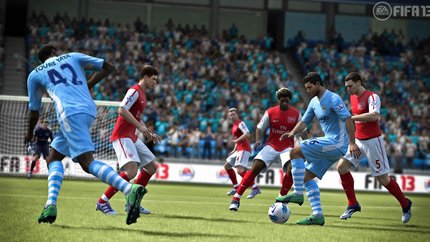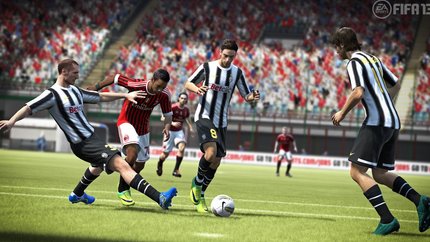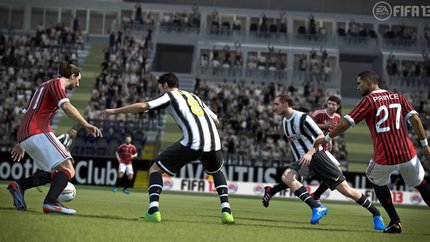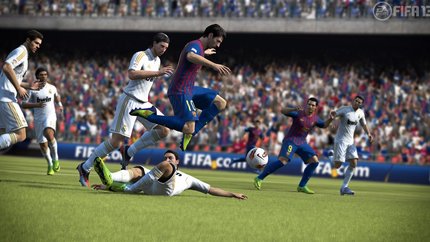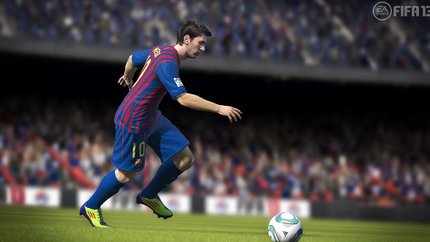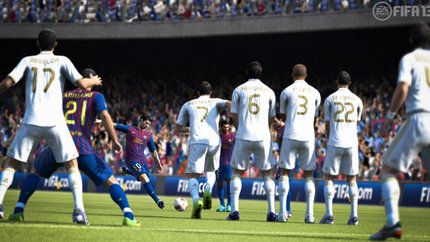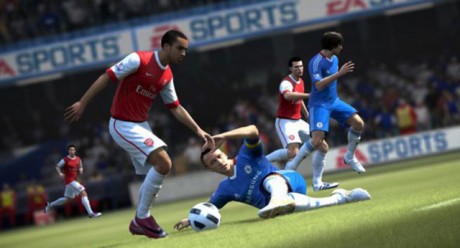
Is FIFA 13 the revolution EA is making it out to be, or are we just in for a new set of tweaks? It is 11:05 AM. I am out of breath and covered in crumbs. Not just any crumbs, mind, but the crumbs of a Danish hastily eaten on a mad sprint to a meeting (there is nothing crumblier than a press-junket pastry). If sacrifices were to be made, though, eating a dignified breakfast was to be rightly one of them. For this was the grand unveiling of FIFA 13 and I was surrounded by the cream of the sports gaming press: a cadre of journalists from across Europe, all wide-eyed and eager to hear about the latest updates to the FIFA franchise. None of them were late or covered in crumbs.
There was no time to wallow in crumb-related self-consciousness, though. Important people were waxing lyrical on the future of the FIFA franchise. “Revolution, not evolution”, said lead producer David Rutter. “Captures the unpredictability of real world football”, said line producer Nick Channon.” The world’s most connected brand in sport”, said Andrew Wilson, the head of EA Sports. This was a finely tuned marketing machine at full power.
The substance beneath the marketing spiel is five fundamental new features designed to enhance the way FIFA plays: an improved Player Impact Engine, AI improvements, a better dribbling system, tactical free kicks, and a brand new first touch system. Here’s the lowdown on each.
Player Impact Engine
The Player Impact Engine is getting a range of tweaks. One of the biggest upgrades removes the comical pile-ups that occurred when players fell into each other, resulting in moments like the infamous Fabianski kiss. An algorithm will detect when a pile-up is happening and trigger a range of new animations that let players roll out of the collision without looking like they’re trying to make out with each other.
Player statistics such as strength and balance will also affect the Player Impact Engine, particularly in push/pull situations. Stronger players will have an advantage in trying to win back the ball against weaker players, complete with new animations. The whole push/pull mechanic has been tweaked to be much stronger this time around, too, but there’s a greater risk of conceding a free kick, should you use it too much.
Player statistics also play a greater role in off-the-ball situations. Defenders can use their size and strength to force opposing players into poor touches or bad decisions before they receive the ball. This potentially lets you interrupt the flow of the game, or better defend set pieces without actually having to steal the ball from the opposing team. It results in a “better balance” between attacking and defending, according to team EA.
Artificial Intelligence
A new positioning code makes up the bulk of the AI improvements, which should prevent many of the weird zigzag runs that happened in FIFA 12. AI players will analyse the whole length of a run by thinking two plays ahead, rather than just one. That means they will look at who will receive the ball next, and who is most likely to receive the ball after that, hopefully making better use of space and opening up more opportunities for creative goal scoring.
The referee gets an IQ upgrade too, or rather a sort of downgrade to make him more human. That means there will potentially be less super-human and ultimately unrealistic decisions. Referee position, line of sight, and a dose of human-fallibility should mean that sometimes mistakes will be made and decisions will sometimes be questionable.
Complete Dribbling
In addition to the 360-degree dribbling already in place, FIFA 13 will respond better to how far you push the analogue stick in a certain direction. You’ll be able to slow down the pace during a run, allowing you to navigate better between opposing defenders. It’s more natural as well, with players no longer having to face the direction in which you want them to dribble. That means you’ll be able to dribble in any direction, but always face the goal, much like players do in real life.
As well as looking more natural, It’ll also make it easier to shield the ball from defenders and get around them with skill moves. Tied into that is the introduction of the ball control mechanic from FIFA Street, that lets you stop the ball and move it around on the spot with your player’s foot using an analogue stick. It was a great feature in FIFA Street, and it is a pleasant surprise to see the core FIFA team taking some its improvements on board.
Tactical Free Kicks
Free kicks have traditionally been rather static affairs in the FIFA series, but 13 aims to change all that with a new Tactical Free Kick system. You’ll be able to position up to three players around the ball, two of which can perform a dummy to throw off the opposition. To balance that new ability out, defenders have the option of deciding how many players to put in a wall, whether to risk the wrath of the ref and tiptoe it forward, and when to jump. This results in a neat cat-and-mouse game between the two teams, with defenders trying to ensure they don’t jump on a dummy and attackers making trying to decipher when the jump is made.
First Touch System
The final improvement EA unveiled for FIFA 13 was a brand new first touch system. It attempts to rectify the somewhat unrealistic first touches of FIFA players, who have the uncanny ability to control the ball to a dead stop, regardless of the type of ball coming into them. The new system takes into account external factors like how fast the ball is travelling, the height, and the angle, as well as player attributes, affecting how accurately the player is able to control the ball. This should result in more pop-ups, miss-hits, and the ball simply running away from players.
Evolution Not Revolution?
After two hours the presentation was over and the coffee had run out. And while my knowledge of FIFA was all the richer, I couldn’t help thinking that perhaps FIFA 13 won’t be quite the “revolution” that David Rutter was making it out to be. Sure, the “new” features are great, but many of them are merely enhancements of old ones. There is no huge overhaul that compares, for instance, to the Tactical Defending System in FIFA 12. Nor is there a great leap in the visuals to lust over–at least at this stage. Revolution? Perhaps not. But an already great game made better? That’s still something to get excited about.
